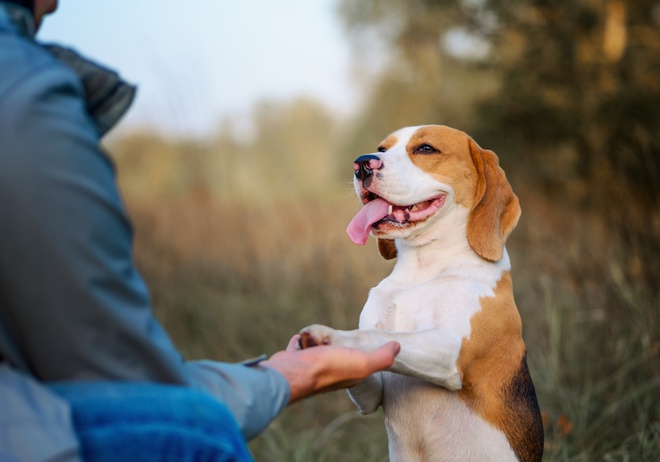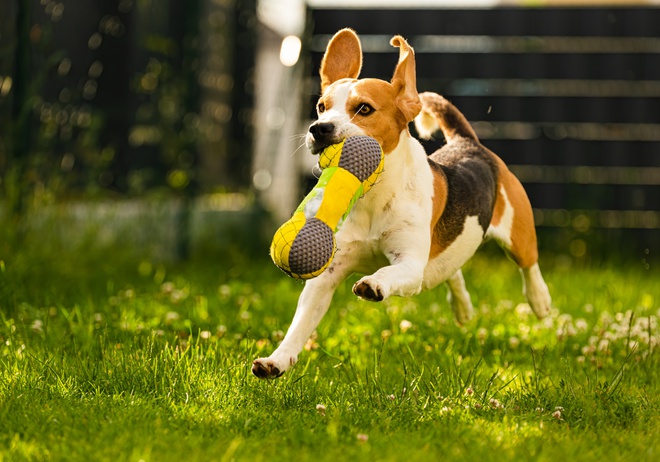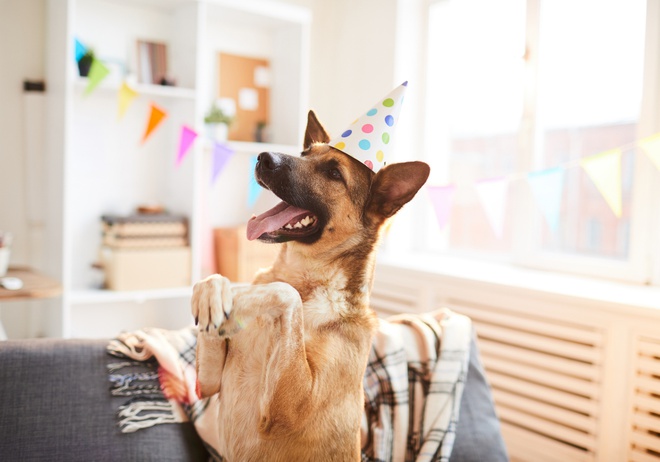8 tricks to teach your dog
Teaching a dog tricks might seem like a difficult task that only professionals can deal with, when in reality it can be very simple, pleasant and rewarding at the same time. In this article, you can find 8 tricks on different difficulty levels that you and your dog can work on together.

Reading time : 7 min
Majority of the dog owners limit their dog’s training to basic commands, such as sit, down, come and stay, when there are many other, more fun, yet still easy tricks they could move on to. House-training process doesn’t require help of a professional dog trainer or behaviourist, and some of the tricks can be taught even to a puppy.
Teaching your dog tricks can be a perfect opportunity for you to bond more with your pet, at the same time providing them with a stimulating and challenging activity. If you struggle to find time to play with your dog, training them can also serve as an occasion to show your affection. Moreover, it’s one of the best ways to improve the communication between the two of you. And imagine the awe on the faces of your family and friends when you present them the tricks you have mastered together!
TOPICS
Tips on teaching your dog tricks

Be patient
Like any form of pet training, teaching your dog tricks might be a long process. Make sure to start with the easiest tricks and increase the difficulty level gradually. Be patient and don’t get angry if your dog takes more time to master a new skill – the training is supposed to be fun for the both of you. Avoid yelling at your pet and speak calmly using an encouraging tone of voice, as any type of canine training should be based on positive reinforcement. Under no circumstances should you use punishment methods to make your dog more submissive – this might lead to behaviour problems and aggression.
Allow some rest and reward
Remember that to learn some of the tricks can be challenging and exhausting for your dog, both physically and mentally, so keep the training sessions short and upbeat in order not to discourage them. Repetition and patience are the key to success. Another great motivation for your dog will be delicious treats – they are an essential part of the training. Always keep healthy and high-quality treats at hand.
Get the right tools
When teaching your dog new tricks, you may resort to the use of a clicker. It’s an extremely useful tool used in training by conditioning. To find out more about clicker training, read our article in Chapter 7 of this guide.
Easy tricks to teach your dog

You can find dozens of tutorials and dog training videos on how to train a dog to do tricks at different difficulty levels, and it’s good to have your ambitions and aspirations high. At the same time, remember that training a dog might be a long process, so start your training classes with the tricks that are simpler and more straightforward. If you’re a beginner in dog training, try the following easy dog tricks first, before moving forward to the more complex ones.
How to teach your dog to shake hands
Shake hands is probably one of the easiest tricks to teach your dog, as it’s dog’s natural instinct to paw at you when they want something. Get your dog to sit next to you, take one treat and close it in your fist. Next, present the closed fist to your dog. As soon as they paw at your hand, use the clicker, and give them a treat.
Repeat it several times, and when you can see that the dog has learned the behaviour, start adding a verbal command “shake” just before giving the dog your hand. After some time, start showing your dog the empty hand, but still reward them with a treat after they give you a paw. As an alternative, you can also try teaching your dog to high-five.
How to teach your dog to kiss
Although teaching your dog to kiss is a relatively easy trick, it can also be quite tricky since dogs love to lick. With some practice, however, you can make your dog give you kisses just on the cue.
Before starting the training, prepare your dog’s favourite treats and a clicker, if you’re using it. As the dog sits next to you, hold one treat up to your cheek and wait for them to get closer to your face with their nose. As soon as it touches your cheek, praise them (or click), and give them the treat to prevent them from licking you. Repeat this several times so that the dog learns the behaviour, gradually introducing a gesture and a command “kiss.” Keep practicing and you’ll realise your dog gives you kisses on command in no time!
How to teach your dog to fetch
This trick is a classic that, unfortunately, doesn’t come naturally to all dogs. If that’s the case with your dog, you might need to put a bit more time and effort in teaching your dog to fetch. Although this type of training has to take place outdoors, in a garden or a park for example, try to find a space where the dog will not get too distracted. Moreover, it’s important to choose your dog’s favourite toy – that increases the chance of them fetching and bringing it back.
Start by throwing the toy not far away so that the dog goes chasing it. Then, command them to come back once they pick up the toy. At the beginning, you may also use a leash to help you summon the dog back. Make sure to praise the dog and reward them with treats when they bring the toy. With time, you’ll be able to reduce the treats and start increasing the distance by throwing the toy a bit further away.
How to teach your dog to spin
Teaching your dog to spin might seem complicated at first, but we assure you that with the right technique, the success is guaranteed. Keeping the treat in front of your dog’s nose, lure them into a standing position and then make them turn around. Use the clicker when the dog finishes the spin and reward them with a treat.
After some time, you might try luring your dog without a treat in your hand, but remember to always praise and reward them after a successful spin. Once spinning on the visual cue is under control, you can add a verbal command “spin.”
To succeed with this trick, remember to teach the dog spinning in one direction at the time not to confuse them, and to keep the treat low, so that they don’t try to jump to it.
10 questions to test your pet training knowledge
Do you know everything there is to know about training dogs and cats? Answer our 10 questions to find out!
More advanced tricks to teach your dog

Once you’ve mastered the basic tricks, you and your dog should be ready to up your game and move to higher level. We encourage you to try teaching your dog one of the following, more advanced tricks.
How to teach your dog to bow
Teaching the dog to bow is based on the same luring gesture as down, so make sure that your dog has this trick under control before starting with the new one. Firstly, make your dog stand still without shuffling their feet around and keep feeding them treats as long as they stay in this position.
Then, move the treat into the dog’s direction so that they make a small shoulder dig, rewarding every successful movement with the treat. Once your dog has this move under control, without shuffling their feet, you can start making the dip deeper, eventually going all the way down to the floor. It’s important to feed your dog treats already in the standing position, so that they learn the whole movement. Similarly to the previous tricks, you may want to add a verbal command, like “bow,” as well as a release cue.
How to teach your dog to play dead
To teach your dog to play dead might take a bit more persistence and time, but it is definitely worth it. Start by putting your dog in a down position. After you get them to lie down, lure them with a treat to roll on their side, at the same time saying the verbal cue “play dead.” As soon as the dog is in the laying position, praise them and reward them with the treat (and click if you’re using the clicker). Repeat the trick, fading the lure with time and introducing hand signals and a verbal cue. After some time, you can also train your dog to lie in the position for longer.
How to teach your dog to sit pretty
Sit pretty is not only an effectively looking trick, but it is also a great exercise for the dog, helping them build core muscles and keep balance. However, before starting the training, check with the vet to make sure that your dog is healthy, as the position can strain pre-existing conditions. Always put your dog’s safety and well-being first.
Lift the treat over the dog’s nose and lure them into position. Click and praise the dog as soon as their feet move off the ground, then give them the treat. Make sure that your dog is sitting straight on their back feet. If they find it difficult to keep balance, you can support their weight with your arm or a chair. Once the dog stays in the position for 5 seconds, you can start removing the lure and adding a visual and verbal cue, for example “sit pretty.”
How to teach your dog to hug
Teaching the dog to hug is a piece of cake once your dog knows the sit pretty trick. Start by making your dog sit pretty, then lean forwards saying “hug” and wrapping your arms around your dog at the same time. Use the clicker and reward your dog with the treat when they execute the trick. Gradually turn to just using the hug command, at the same time teaching your dog the visual cue, which might be opening your arms.
If you know that your dog doesn’t feel comfortable when they’re being touched, gets fearful and anxious when you try to hug them, it’s better to focus on different tricks or make use of dog training services.
Conclusion
Introducing various activities into your dog’s life is a crucial part of caring for their well-being. Teaching them various tricks can be one of such activities, and besides making sure that your dog receives enough entertainment, you will also have a chance to strengthen the bond between the two of you.
Similarly to other types of training, when teaching your dog tricks, you need to be patient and perseverant. By focusing not on the result, but on taking pleasure from spending quality time with your pet, you won’t even notice when your dog makes substantial progress.
Continue reading our guide
This article is a part of a complete guide on the subject. Do not miss the next chapters.
Do you know everything there is to know about training pets?
Answer our 10 questions to test your pet training knowledge.


